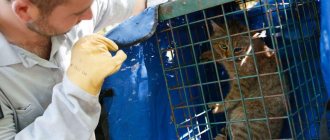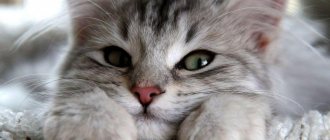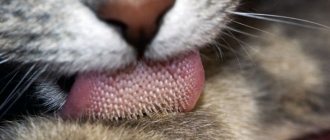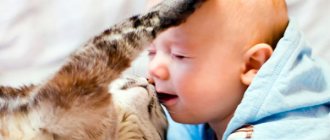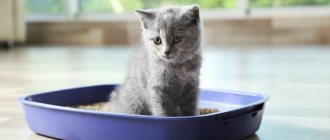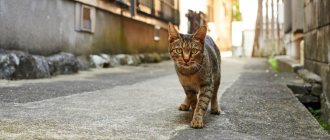Origin
The gene that leads to the absence of fur in a cat has been manifesting itself for a long time. Hairless kittens have occasionally been born to representatives of various cat breeds. The owners perceived such pets as a funny misunderstanding.
The first described pair of hairless pets was bought by Mr. Shinnik in Mexico from local Indians. The owner was unable to obtain offspring from the strange animals, but left a detailed description of the animals, which made further research possible.
Soon a hypothesis arose that hairless seals are descendants of animals brought from Europe to South America in the 15th century. The loss of wool could be provoked by a sharp change in climatic conditions.
Later, in the 20th century, Siamese cats living in France began to have kittens without hair. Breeders tried to crossbreed these animals in order to consolidate the species trait, but the attempts remained unsuccessful.
At the origins of the breed of modern hairless cats is a Canadian cat, born in 1966. The descendants of the cat received the common name Sphinxes, due to their resemblance to ancient Egyptian images. Many researchers are confident that ancient sculptures in the Egyptian desert are images of hairless cats.
Thanks to their unique grace, cats without fur are becoming increasingly popular. The following describes the standards and varieties of breeds of these graceful creatures.
Photo of the Sphinx
Why are cats hairless?
global $ads_google;
//data-ad-slot=”2475549904″ $ads_google = empty($ads_google) ? false : true; ?> if ($ads_google == false) {?> $ads_google = true; ?> } ?> The mentioned cats Nellie and Dick turned out to be relatives, which is probably why the owner did not breed the breed, although he gave the animals a detailed description.
By the middle of the 20th century, information about the appearance of kittens without fur began to appear in the media from different countries.
It is believed that a kitten named Prune from North America became the ancestor of the Canadian Sphynx. The Don Sphynx was registered in 1998; the wonderful cat Varvara is considered the ancestor. It became clear that new
horizons for breeding cats. They began to actively breed hairless cats after the 80s of the last century.
A mutation led to the appearance of bald purrs in the world - thanks to this genetic failure, which is hereditary, the world saw new breeds of cats.
Appearance standard
Of all the types of hairless cats, three types of Sphynxes have passed all stages of official recognition: Canadian, Donskoy, Peterbald. Each breed is characterized by its own standards, compliance with which is monitored by international organizations. The largest breeders' association is ISBFA.
Appearance description:
- Muscular body of medium size, distinguished by grace and fine lines.
- There is practically no hair. A few short hairs create a thin velvety layer on the surface of the body.
- The specific location of skin folds indicates genetic differences.
- The presence of vibrissae, fluffy brushes on the limbs, and eyebrows is acceptable.
The geometry of the body and head of animals is different, making it possible to accurately determine whether a cat belongs to one type or another. A common feature is the active temperament and attachment to the owner, usually characteristic of dogs.
Color
There are various colors of hairless cats:
- plain (snow-white, charcoal, orange, bluish-gray, pink, purple, brownish);
- bicolor (gray-white, lilac-gray, brown-chocolate);
- with a pattern of various shades (tabby);
- tortoiseshell (black-red, cream-blue, cream-lilac);
- piebald (colored spots on a white background);
- colorpoint of various color combinations.
Silver colors of the Sphynx are not possible due to the lack of hair.
The variety of shades leads to the unique color of the skin of each individual. Having sunbathed a little under the sun's rays, the pet will look even more elegant, but such procedures should not be overused.
Character of hairless cats
All bald people have a friendly character. They are characterized by devotion and love of affection - few hairless cats will allow their owner's embrace to be empty. Pussies make friends with all members of the household, but they experience true love only for those who give them a lot of time and attention.
global $ads_google; //data-ad-slot=”2475549904″ $ads_google = empty($ads_google) ? false : true; ?> if ($ads_google == false) {?> $ads_google = true; ?> } ?>
The price of hairless cats remains high not only because of the special grace of their body, but also because of their developed intelligence.
Animals have a negative attitude towards forced loneliness, so it is better to have them in a large family, where everyone will find time to communicate with the pet.
Top 10 Popular Hairless Cat Breeds
Three basic types of hairless pets arose as a result of natural mutations (Canadian, Donskoy, Kohona). The rest are the result of selection work:
- Crossing the Oriental with the Don Sphinx made it possible to obtain the Peterbald.
- The Canadian Sphynx and Munchkin became the parents of Bambino kittens.
- Levkoy descended from the Don Sphynx and Scottish Fold.
- The Minskin is the fruit of a complex cross between a Canadian and several breeds.
- Dwelfs and Elves carry the genes of the Canadian, American Curl and Munchkin.
Canadian Sphynx
- This popular hairless pet has the following characteristics:
- Dense, smooth skin, sometimes with a small hairy fluff.
- Wrinkles on the limbs, forehead and neck area, decreasing with age.
- Muscular torso, shaped like a pear.
- Thin paws.
- An elongated tail in the shape of a whip, twisted in an arc.
- Wedge-shaped skull with sharply defined cheekbones.
- Round large ears.
- Lemon shaped eyes.
Many note the Canadian’s resemblance to an alien creature, thanks to which the cat received the unofficial title of “cat from the moon.”
Don Sphinx
At first, these cats were called “Russian Hairless”. Representatives may have different types of hair:
- Completely hairless.
- Slightly noticeable fluff, which subsequently disappears completely.
- A small number of hard short hairs (brush).
- Barely noticeable hairs measuring from 2 to 3 mm (velor).
Distinctive features of the body: medium size, folds on the paws, neck, forehead and groin. The head is short, wedge-shaped, the eyes are shaped like almonds, the ears are large and somewhat pointed.
Peterbald
Thanks to its constitution (elongated body and paws, developed muscles, proud head carriage), this descendant of Orientals is recognized as the most elegant of the hairless cats. On a narrow muzzle with pronounced cheekbones, eyes of bluish-green shades and huge ears stand out. The colors are often dark tones, the folds are concentrated on the head.
Levkoy Ukrainian
The fold-eared hairless cat has a wedge-shaped, pentagonal head, an elongated neck, and narrow green eyes. The animal's ears resemble the gillyflower flower, to which the breed owes its name. Slender, graceful pets have completely smooth skin with minor folds on the tummy, as well as in the neck area and on the head. Minor hair fluff may be present. Levkoys tend to persistently demand attention to their own person.
Elves and Dwelfs
Both of these related varieties of hairless kittens have ears that curl toward the back of the head, making them look like fairy-tale creatures. These cats were bred 10-15 years ago, so they have not yet become widespread. Elves do not have whiskers, but there may be tufts of hair on their paws. Dwelfs are distinguished by their short limbs.
Bambino and Minskin
Thanks to its elongated body and shortened legs, Bambino looks like a dachshund. The cat's face with ears narrowed at the ends has a naive, childish expression. The entire skin of representatives of the breed is covered with small folds. Pets weigh up to 4 kg. They love to play and frolic.
Minskins are almost identical to Bambinos, but have a very thin coat.
Kohona (Hawaii)
Hairless cats from the Hawaiian Islands underwent a natural evolution. The hairless skin of animals is smooth, like wax, when touched. Pets have neither mustaches nor eyebrows. The cheek, forehead and neck wrinkles are very pronounced, as well as folds on the skin of the paws. Almond-shaped eyes.
All types of hairless cats
These 8 hairless cat breeds prove that cats don't need fur to be fabulously beautiful. Most people are familiar with the Sphynx breed, but there are many other hairless breeds to learn about and, frankly, gawk at. And, believe me, many of them will surprise and enchant you with their appearance! The Forkmind team presents:
Bald cat, kitten
Canadian Sphynx
Undoubtedly, the most popular of the hairless cat breeds is the Canadian Sphynx. In 1966, a black and white cat gave birth to a wizened, hairless kitten in Ontario, Canada. Named Prune, the kitten was involved in efforts to breed other hairless cats. This is how the Canadian Sphynx was born! They are usually hairless, but may have some light fuzz on their body. Their characteristic large ears can reach 2-3 inches in height. The Sphynx cat is known for its social, attention-loving, and inquisitive personality.
Canadian Sphynx
Peterbald
The Peterbald is a rare but highly desirable breed of hairless cat. This breed originated when the Oriental Shorthair was bred in 1993 for the hairless Don cat. They can be completely bald, have fine fluff or even fur like a peach. The Peterbald is known to be a very intelligent and extremely affectionate house cat.
Peterbald
Bambino
Bambino cats are a cross between a Canadian and a Munchkin, so they have two characteristic features: hairlessness and short legs. Also known as “little cats” or “little feet”. and Their small size and short legs do not impede movement. Bambinos are friendly, smart and affectionate babies. They will make wonderful indoor cats.
Bambino
Minskin
Like the Bambino, the Minskin breed is a cross between a Sphynx and a Munchkin. Minskins tend to be an even smaller breed, with short legs and areas of fur on parts of their stocky body. These are smart, playful and funny cats. The name "Minskin" comes from a combination of the words "miniature" and "skin".
Minskin
Dwelf or dwelf
Another tiny member on our list of hairless breeds is the Dwelf. The name of this breed comes from a combination of the words “gnome” and “elf”. And for good reason! After all, the cat really looks a lot like a dwarf elf.
Dwelf cats got their short legs from the Munchkin and their hairlessness from the Sphynx. Dwelfs got their beautiful, characteristic curled ears from the American Curl. This breed, as we know, is playful, active and almost dog-like in terms of their psychology.
Dwelf or dwelf
Don Sphynx
The Donskoy, sometimes called the Don Sphynx, is unique on our list of hairless cat breeds. This handsome guy can really grow a winter coat! In fact, this cat may be born with fur and lose it as it ages. Sometimes described as a "real alien", Donskoy has very elastic skin with pronounced wrinkles. This breed is intelligent, friendly and active. Like many other sphinxes, Donskoy is similar in behavior and character to a dog.
Don Sphynx Also interesting: All the most interesting things about the Canadian Sphynx breed
Ukrainian Levkoy
The Ukrainian Levkoy is a recent artificial breed created by crossing hairless Don females with Scottish Fold males. These hairless cats have distinct, inward-curved ears and a muscular but strong and slender body. Their soft, elastic skin appears quite wrinkled. The Ukrainian Levkoy is a very sociable but calm cat.
Ukrainian Levkoy
Likoy
Although Lykoi is often only partially hairless, this unique cat deserves a place on our list. Likoi looks like a real werewolf with his hairless muzzle, “liquid” skin and shiny silver-black fur. He retains strong hunting instincts and loves to track people, other animals, and, if necessary, flies and his toys.
Likoy
Caring for your hairless cat
Many people mistakenly believe that hairless cats do not require any special grooming. In fact, hairless cat breeds still need it: instead of brushing their fur, you will need to bathe your pet weekly to remove oily patches from their skin. Cats with fur tend to absorb these oils; hairless cats may feel sticky to the touch and may develop skin problems.
Additionally, your hairless cat needs protection from the sun and harsh weather conditions.
Talk to your vet about sunscreen for cats and buy some cat sweaters for those cold winter days, after all, your kitty is completely naked! Hairless cats
Behavior
A common feature of representatives of hairless cats is an affectionate, flexible, friendly character. In this way, hairless cats are similar to dogs. They are affectionate and do not tolerate loneliness or change of environment well.
Some individuals can be trained, for example, they can bring light objects to their owner. They are distinguished by their intelligence, curiosity, and understanding of human speech.
They get along easily with small family members and pets. Many owners note that keeping such pets helps maintain a comfortable, relaxing atmosphere in the house.
Care and maintenance
Pet care requirements are determined by the unusual characteristics of representatives of this type of cat. Skin left without the protection of fur becomes vulnerable. In addition, during the cold season, cats can easily catch a cold.
Basic recommendations for caring for pets:
- Treat the surface of the skin with a special composition three times a week, removing brownish plaque that accumulates around the ears, claws and on the pads of the paws.
- Clean ears and eyes with cotton swabs as needed.
- Have a “bath day” at least 2 times a month using special gentle shampoos. Wipe the body surface dry with a soft towel at the end of the procedure.
- Trim claws using a nail clipper.
Proper care will help keep the animal in a good mood.
Health
Hairless pets are especially susceptible to skin diseases and colds. For prevention, the following measures should be taken:
- Maintain the temperature in the room where the cat lives from 20 ⁰С to 25 ⁰С, avoid drafts.
- Limit your pet's time in direct sunlight or near heaters to avoid burns or heat shock.
- In winter, dress the cat in special clothes to prevent hypothermia.
- Monitor the condition of the cat's lacrimal glands and ear canals, not forgetting about regular hygiene procedures.
- Monitor your pet's diet to rule out gastrointestinal diseases and excess weight problems.
- Vaccinate the animal in a timely manner (primary vaccination at 2 months, after reaching the age of 1 year - annually).
If the requirements are met correctly, hairless cats live a full life, the normal duration of which is 15-20 years.
The choice of a hairless cat as a pet is often due to the presence of allergic diseases. It should be understood that allergies are most often caused not by the pet’s fur itself, but by the D1 protein produced by the cat’s glands. Before purchasing an animal, you should conduct the necessary tests to identify the source of the allergy. If the allergen is protein D1, the patient is advised to limit contact with any cats.
Hairless breeds care
global $ads_google;
//data-ad-slot=”2475549904″ $ads_google = empty($ads_google) ? false : true; ?> if ($ads_google == false) {?> $ads_google = true; ?> } ?> Cats have no fur
very delicate skin that needs care and hygiene. Dirt often accumulates in the folds, so the skin is washed with baby shampoo. Surprisingly, many pussies are ready to splash around in a warm bath for hours. The owner’s task is to ensure that water does not get into the ears - you can stuff the ear canals with cotton wool. For a bath, the optimal water temperature is 36-38°C. A rubber mat is placed on the bottom - without it, a cat that slips will remember for a long time the offense against you and the whole wide world.
They take into account the dislike of hairless creatures for showers - you will have to wash off the shampoo with your palms.
If the cat has a pronounced reluctance to bathe, the bath is replaced by wiping with cotton pads soaked in lotions for baby skin.
If your pet sweats a lot, the discharge must be removed with cotton pads and lotion.
The skin may dry out excessively after contact with water, so it is recommended to lubricate it with baby oil.
Keeping hairless cats
If you want to buy a hairless cat, then it is important to understand that such pets should not be left to their own devices, they definitely need attention and good care. Their health needs constant monitoring, because wool will no longer serve as protection from external factors.
If you are a too busy person, then you should not make life difficult for either your pet or yourself - after all, both kittens of hairless cats and adults take up a lot of time.
Such an animal requires living in a warm place - they tend to freeze and do not have the opportunity, like other cats, to warm up under their own thick fur coat. Such pets can often be seen next to a radiator or heater. To prevent skin burns, caring owners place a thick cloth on the cat’s favorite place.
Carefully walking hairless cats
- the sun's rays can also burn the skin, and the absence of fur does not in any way protect the body from a shock dose of ultraviolet radiation. The time for walks is calculated so that the cat does not walk under the scorching sun.
Feeding
A good owner will treat the pet with care and will not allow it to receive less nutrients or eat low-quality food.
This article will tell you about the basics of proper nutrition for adult Sphynx cats and their offspring.
You can feed your pussy with industrial or natural food. The age of the cat is always taken into account: a different diet is suitable for kittens, as is the case for older individuals. Lactation, pregnancy, illness, castration play a big role.
The menu includes meat, skinless and boneless chicken breast, chicken offal, vegetables in any form, fruits, parsley. You can give steamed oatmeal, buckwheat or rice. Three times a week it is useful to feed your pussy with pharmaceutical brewer's yeast. Once a week, cheese and chicken yolk are included in the diet.
To cleanse your teeth, it is useful to add crackers to your food.
Diet
Animals that lack a layer of fur are forced to expend more energy to maintain a normal body temperature. For this reason, hairless cats should receive more high-calorie food. Basic recommendations for the correct selection of food:
- Avoid granules with high vitamin content. Such components are necessary for the beauty of the coat, but can cause harm to a bald cat.
- The diet should include a fairly large percentage of fat. Proteins with carbohydrates can remain at a basic level.
- When feeding natural products, you need to choose raw poultry and beef, boiled vegetables, meat, liver, and dairy products. The components can be crushed until smooth, added to soft foods, or given in their natural form, depending on the cat’s preferences.
Coticus subbush. Scientists have found a new species of cat in Corsica, and it hides better than a ninja.
Employees of the French Wildlife Authority have found and filmed a new species of cat discovered on the island of Corsica. The predator has long fangs, the habits of a secretive ninja, and local residents make up frightening legends about him. But journalists do not share the opinion of scientists.
A new species of cat found on the Mediterranean island of Corsica was reported by Agence France-Presse (AFP) on June 19. Since 2008, local residents have complained about a predator who ravaged chicken coops and stole milk at night. In 2012, employees of the French State Office for Wildlife (ONCFS) opened a hunt for the offender and installed incense sticks in the forests that could attract the attention of wild animals.
The results were not long in coming: in the same year, researchers discovered fur particles on the sticks. Using a DNA test, experts determined that the predator is a cat that does not belong to a species already known to mankind. ONCFS chief ecologist Pierre Benedetti explained that the discovery was a revelation for scientists.
Based on DNA, we were able to distinguish it from the European forest cat Felis silvestris. The data is close to the African steppe cat Felis silvestris lybica, but its exact identity has yet to be determined.
According to ONCFS field researcher Carlo-Antone Cecchini, during its life in Corsica the animal became an integral part of local mythology. From generation to generation, people told each other legends about dangerous forest cats that come at night. In the Corsican dialect they called the beast ghjattu-volpe. The second part of this word is translated from Italian as “fox”.
Using traps and hidden cameras, specialists managed to track and catch 12 individuals. This happened in 2021, at the same time experts installed chips on the animals to track their habits and location and released them into the wild.
The body length of the animal is 90 centimeters. He has very wide ears, short mustaches and highly developed fangs. The predator has no external resemblance to a fox. The cat got its nickname because of the rings on its tail and its black tip.
Another distinctive feature of the animal is its dense, soft fur, which protects the owner from fleas, ticks and lice.
This is a wonderful discovery,” Benedetti told reporters.
But neither thick fur nor sharp claws can save them from their furry relatives. The individual in all photos is a male between four and six years old. According to ONCFS workers, he injured his right eye in a fight with another male. The result of the contraction is reminiscent of heterochromia - a genetic feature expressed in different colors of the iris of the eyes.
His right eye was damaged in a fight with another male
How did the animals manage to hide from local residents and scientists for years? Experts have determined that the cat-fox lives in places remote from humans, prefers to settle near bodies of water densely overgrown with grass, and is nocturnal. The main danger to her life is not people, but golden eagles, whose size is not inferior to that of a cat.
To see a kitty in action, you don’t have to go to Corsica and risk your life. The agency shared a video of experts examining the animal.
Benedetti has a theory that the cat-fox came to Corsica in the 7th century BC, and was brought by local farmers. According to his assumption, the animal’s homeland is the Middle East. Researchers have not yet found out what kind of food the animal prefers, or whether it lives in groups. This remains to be seen.
Despite the reasoning of experts, a correspondent for Hi-News suggests that scientists risk making a mistake in considering the cat-fox a new species. According to the journalist, the predators may be a hybrid of two species of wild cats from the neighboring island of Sardinia.
No less amazing than the fox cat, the animal is called the civet and lives in Africa. If you haven't heard of this fluffy one yet, it's time to watch him drink milk. After all, the beast does not know how to do this.
People can also be deprived of seemingly basic skills. For example, a woman named Debbie can't take selfies. But that didn’t stop her from launching the most divine PR campaign on Facebook.
Prices
Prices for hairless kittens are determined individually and depend on the pedigree and characteristics of a particular individual. Representatives of the Canadian, Don Sphynx and Peterbald breeds can cost from 10 to 50 thousand rubles. Ukrainian Levkoi are valued from 5 to 30 thousand rubles. The price range for Elves and Dwelfs is 35-120 thousand rubles. Bambino can be purchased for 25-80 thousand rubles. Kittens of the Cohona breed are extremely rare; there is no market price for these animals.
In any case, you should purchase cats only from nurseries, since breeding these pets at home is almost impossible. Adult cats become so attached to the owner that they may refuse to eat in the absence of the owner, so purchasing a pet of this breed should be taken with full responsibility.
The mythical Corsican “cat-fox” turned out to be a real animal
For hundreds of years, shepherds on the French island of Corsica spoke of a mysterious animal with reddish fur, which was called the “fox cat” or “fox cat.” According to their stories, this beast attacked the udders of sheep and goats.
This animal was considered mythical and, according to scientists, peasants either confused the “cat-fox” with an ordinary cat or fox, or simply made up fiction (Paranormal News - paranormal-news.ru).
The cat in these photographs is alive, just under the influence of sleeping medications.
It was only in 2008 that the first such animal was caught in a chicken coop and found its way to biologists. And over the following years, several more large cats were found and delivered to scientists in local forests.
Scientists have studied the DNA of this animal and probably in the coming years the existence of a new subspecies of wild forest cat will be announced.
The Corsican "fox cat" is slightly larger in size than the average domestic cat and its fur is really reddish and very thick. She also had a thick tail with a blunt end and black rings - one of the signs of wild forest cats. Domestic cats have thinner tails and often have a pointed tip.
According to Carlu-Anthony Ceccini, these cats live only in a small remote area, where they are protected from people by water on one side and forests on the other. Their main enemy is the golden eagle.
“From generation to generation, local shepherds told stories about how red forest cats attacked sheep and goats, aiming for the udders with milk. However, for the first time the “cat-fox” was caught in a chicken coop, where he was trying to catch a chicken.”
“Having studied its DNA, we found out that these cats are not close to European wild cats (Felis Silvestris Silvestris), but they are similar to the steppe wild cat (Felis Silvestris Lybica). However, its exact species will need to be studied more carefully,” adds Ceccini.
Since 2008, 16 such cats have been caught in the forests of Corsica, 12 of which fell into the hands of scientists, were humanely examined by them, and then released back into the wild.
One of the last cats was a male with a slightly damaged eye. One of his eyes is normal and the other is dark in color. It is this cat that is presented in all the photos in this article.
The cats released into the wild were fitted with GPS collars to track their movements.
According to researchers, these wild cats may have arrived in Corsica thousands of years ago. It is surprising that such a large animal living in Europe came to the attention of scientists only in the 21st century. Such stories always inspire cryptozoologists, who also hunt for creatures called mythical.
